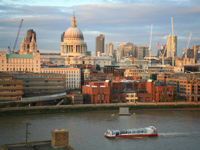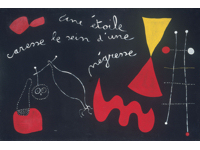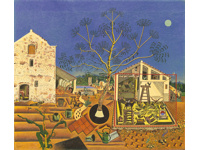Reviewed: Joan Miró at the Tate Modern
Big, brash and colourful: the Miró exhibition is a hot ticket in London right now, and visitors get the bonus of a trip to the architecturally stunning Tate Modern thrown in.
Some people visit the Tate just to look around the enormous high-ceilinged Turbine Hall and to laze in the comfy armchairs, or even to catch the river views from the upper floors. But right now add in a chance to see this must-see exhibit with some of the greatest paintings from the celebrated Spanish Catalan artist and this is a great double deal.
 There are great views of London from the upper deck of the Tate
There are great views of London from the upper deck of the TateiStockphoto/Thinkstock
Walking into the Miró exhibition at the Tate Modern on a Saturday lunchtime, I expected to do battle. Tour groups, families, the art gallery crowds can be a mildly unruly lot as anyone who went to see the blockbuster Gauguin exhibition in London earlier this year will know. But I’m pleasantly surprised to find that there are no huge groups, no craning necks or sharp elbows just to get a single glimpse. I put this down to good fortune rather than being a reflection on Miró.
By rights I should’ve been fighting them off. Entry times are staggered to prevent overcrowding, so that helps. But the best time to see the Miró is on a Friday or Saturday evening, when would-be visitors are out to dinner. Avoiding lunchtimes and weekends, as well as the opening and closing weeks when the hype is at its greatest is also a good strategy.
 Joan Miró, A Star Caresses the Breast of a Negress (Painting Poem) 1938
Joan Miró, A Star Caresses the Breast of a Negress (Painting Poem) 1938 Tate © Successió Miró/ADAGP, Paris and DACS, London 2011
The buzz had been big on Twitter and I was eager to see whether the Spanish painter I associate with childlike whimsy and abstract, amoebic creatures would surprise me. I’d been prepared for paintings like A Star Caresses the Breast of a Negress (1938) and Dog Barking at the Moon (1926), showcasing Miró at his fluid best. What I wasn’t expecting was (notwithstanding a few deviations) quite how consistent his visual vocabulary would remain over a career spanning 70 years.
The exhibition, the first of Miró that the Tate has put on in 50 years, runs in chronological order, with 13 rooms dedicated to each stage of his career. It starts with the folksy early drawings of his Catalan home and paintings like Mont-roig, the Church and The Valley (1912), swiftly giving way to works that belie the influence of Surrealism on the artist – familiar motifs, such as abbreviated squiggles, stars and the escape ladder, start to make an appearance in drawings such as The Farm (1921).
 Joan Miró, The Farm, 1921-2
Joan Miró, The Farm, 1921-2 Successió Miró/ADAGP, Paris and DACS, London 2011
The focus of Room 6 is the Barcelona collection, a black and white series of political prints made in 1939-1940, with Spain under the control of General Franco and Europe on the brink of WWII. These flow into the Constellations series which were, for me, the highlight of the exhibition. Painted during 1940 and 1941 whilst Miró was in self-imposed exile, the collection of around 15 small graphic drawings had the room to themselves and their use of intense colour, detail and density evoked a sense of playful energy and urgency that seemed lacking in the earlier Barcelona series.
 Joan Miró, The Escape Ladder 1940
Joan Miró, The Escape Ladder 1940 Successió Miró/ADAGP, Paris and DACS, London 2011
The second part of the exhibition focusing on his later work, displays sculptures produced during the 1960s, and towards the end of his career, influenced by American Abstract Expressionism, are triptychs exploring use of space and colour, including Fireworks (1973-75), a piece reminiscent of Jackson Pollock’s fantastic splashes.
The Tate has tried to frame each piece within its political context, helping visitors to grasp some meaning from the abstract paintings. Miro’s paintings became a symbol of rebellion in the repressive years of the General Franco regime in Spain and his work also responded to the Spanish Civil War. While avid fans of Miró might find this extra layer of political context a distraction, I think most will find it useful. Go and see it; both thought-provoking and enjoyable, Miró might just surprise you.
Joan Miró: The Ladder of Escape
Tate Modern, South Bank
www.tate.org.uk
Until September 2011 in London, before going on tour to Barcelona and the National Gallery, Washington.
Admission - £15.50; concessions - £13.50
Opening times: Sun- Thurs 1000- 1800; Fri-Sat 1000-2200
Other blockbuster exhibitions around the world:
NEW YORK: MoMA - Alexander McQueen: Savage Beauty
On til 31 July.
The 2011 Costume Institute exhibition paying homage to the late fashion designer Alexander McQueen has been the most popular in the Costume Institute’s history with over 5000 visitors a day. It features around 100 fantastical designs and 70 accessories spanning his career; from his Central St Martins debut up until his death in 2010. A must-see.
PARIS: Grand Palais – MONUMENTA 2011 featuring Anish Kapoor: Leviathan
On til 23 June.
Every year, MONUMENTA invite an artist to create a specific art work for the Grand Palais Nave - previous participants have included Anselm Kiefer and Richard Serra. This year it’s the turn of Anish Kapoor, the Bombay-born artist and he has taken on the brief with aplomb, creating Leviathan, a 35m-high spherical sculpture. Visitors are immersed in a cavernous chamber, bathed in disconcerting red light, before they emerge to marvel at the true scale of the structure.
LONDON: Hayward Gallery - Tracy Emin: Love Is What You Want
On til 29 Aug.
Ever the provocateur, Emin always elicits a reaction, be it good or bad. The Hayward is putting on this survey as part of their 60th anniversary celebrations of the Festival of Britain which perhaps shows just how far Emin has come, from original YBA to being heralded as one of the establishment. On display are her famous appliqué blankets, lesser-seen early works, as well as a new collection of specially commissioned sculptures.
ST. PETERSBURG: The State Hermitage - Blitz and Blockade: Henry Moore in the Hermitage
On til 28 Aug.
Best known for his sculptures, the State Hermitage museum is displaying a collection of Moore’s “Shelter Drawings”, which depict Londoners hiding in the Underground during the Blitz. The impact of the artworks is heightened by the fact that they are on display in the museum’s basements - these were used as shelter during the Siege of Leningrad; this year is the 70th anniversary.
Do you have any Feedback about this page?
© 2025 Columbus Travel Media Ltd. All rights reserved. No part of this site may be reproduced without our written permission, click here for information on Columbus Content Solutions.









 You know where
You know where